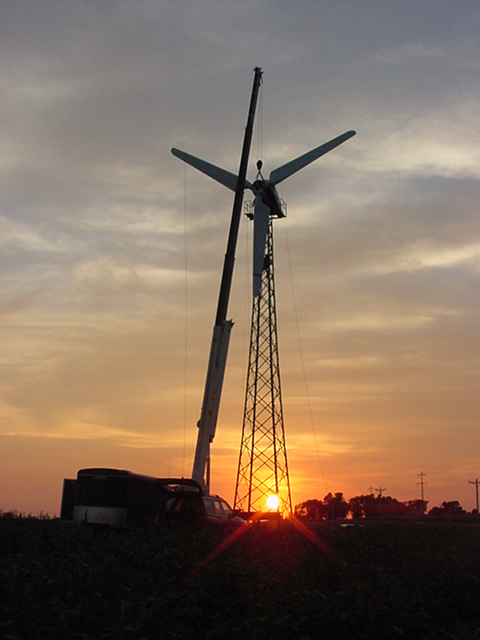The “Windy” City has … gasp… WIND!
February 5th, 2006

One of the Springer turbines goes up near Owatonna, Minnesota
A million miles in a #)(*)^$%(*&% truck taught me a few things, one of which was that “The Market” is in “The Windy.” They’ve since built a new produce center, but it’s still, in trucker lingo, “The Windy.” And “The Windy” is in Illinois.

Chicago’s old Water Market — imagine navigating this in a long nose Pete with a 48′ bustle at 2 a.m., something I’d rather forget.
I digress… anyway, sigh… I heard again recently the claim that all this transmission across Minnesota is needed to get ND and SD wind to Illinois because Illinois doesn’t have wind. My official professional legal opinion of that: WHAT A LOAD OF CRAP! … ahem… There is wind in Illinois, and there’s wind potential in Illinois, and there’s even wind REALIZED in Illinois. Here’s the real poop from the DOE, which incorporates in their new wind information, which goes beyond those estimates I saw a few years back:
Here’s how they figure the “9,000MW potential” wind capacity, with the understanding that this is just like all other “potential” estimates, what good is it if it isn’t developed. As John Dunlop says, capacity matters, BUT if you’re figuring 30% line loss for SW MN to Metro, 200 miles, what is line loss for transmission lines three times as long — 90% line loss, eh? So then what’s the point of generating wind and transmitting it long distances? It sure isn’t efficient. Anyway, here’s the verbatim DOE take on Illinois capacity:
The wind potential from these windy lands is about 3000 MW of installed wind generation capacity. In a class 4 wind regime, the annual average output of a wind power plant is typically about 25% of the installed capacity. The class 4 areas represent about 0.4% of Illinois’ land and are largely rural agricultural areas.
Because of likely advances in technology and the significant incentives available in Illinois, a number of additional areas with only slightly lower wind resource (class 3+, or 14.3 – 15.7 mph) may also be suitable for wind development. These class 3+ areas highlighted on the map of best areas represent an additional 6000 MW of wind potential.
The total amount of class 4 and 3+ lands combined is about 1800 square kilometers (1.2% of Illinois’ land area), and the wind potential from these areas is about 9000 MW. Each square kilometer may support about 5 MW of installed wind capacity. All urban and environmentally-sensitive lands (state parks, wildlife refuges, etc) have been excluded in estimating the wind potential.
Bottom line? The “wind is needed in Illinois” is a poor rationalization for enabling construction of utility infrastructure at our expense so utilities can profit from unregulated activity where there is no market (and if you’re thinking, “but they won’t profit if there’s no market, that’s right, that’s a big part of the problem, because then we’re holding the bill for something we paid them to build and went belly up — it’s where developing nations are when the IMF overprojects need and ‘loans’ them money to build what they don’t need — prices rise to cover debt service and r egular people can’t afford essential services and next thing you know they’ve got rioting in the street! Don’t forget that Mesaba’s Julie Jorgensen cut her teath on IMF and World Bank utility financing.)
“Oh, well, we need it in Wisconsin… yeah, that’s it… we need it in Wisconsin.” Yeah, right… here’s the Wisconsin info: Wisconsin Wind Maps
According to this 2004 ELPC Wind Map, there’s 3 times as much wind proposed for WI (1,657MW) as there is for SD, and 6 times as much wind proposed for ILLINOIS (3,119MW) as there is for SD.
Don’t buy this “we need it in (name that easterly state)” crock o’ crap — remember that wind blows everwhere, and much of it is sufficient to generate wind. Key words to remember: SUFFICIENT and EFFICIENT. For any project, ask what it does for the local economy, and ask what it does to decrease need for noxious generation.
Leave a Reply